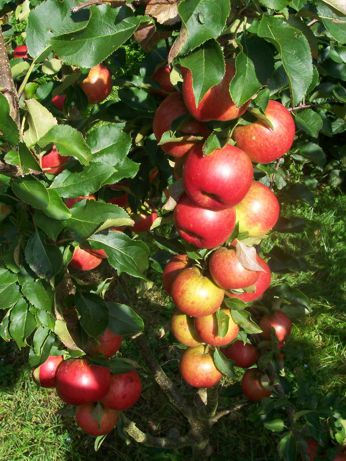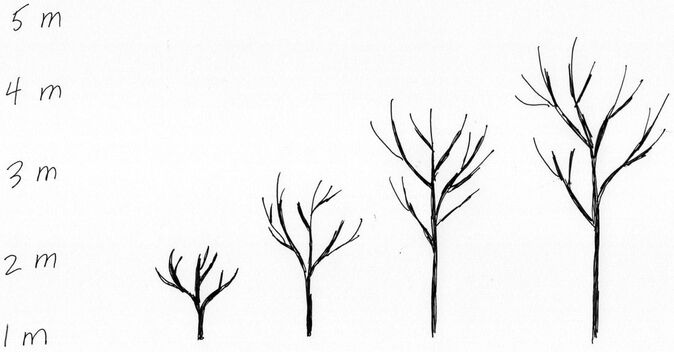Tree Health

Tree health is dependant on variety, rootstock and site.
Variety
Every pip, from every apple has the potential of growing into an apple tree distinct from any other. But not all are worth growing. Four thousand years ago in China, and even earlier in Mesopotamia, man has been able to propagate specific varieties through grafting. Today we can still grow a particular apple tree that originated centuries ago on some remote slope of the Fertile Crescent.
Besides diversity resulting from individual pips, varietal differences occur through mutations. An apple tree can produce a shoot or branch with different characteristics and fruit to the rest of the tree. These “sports” are often an improvement of the type, and are propagated by grafting.
The careful breeding and selection of apple cultivars continues today to address the changing needs of the apple growing industry.
Apple diseases such as scab, canker, mildew, fireblight, brown rot and bitter pit can ruin crops. Some varieties can only be grown successfully with prodigious use of chemical sprays that are detrimental to our environment. Some modern apple breeding programs are using disease resistant species and strains so that future apple production may be less dependant on chemicals.
Variety
Every pip, from every apple has the potential of growing into an apple tree distinct from any other. But not all are worth growing. Four thousand years ago in China, and even earlier in Mesopotamia, man has been able to propagate specific varieties through grafting. Today we can still grow a particular apple tree that originated centuries ago on some remote slope of the Fertile Crescent.
Besides diversity resulting from individual pips, varietal differences occur through mutations. An apple tree can produce a shoot or branch with different characteristics and fruit to the rest of the tree. These “sports” are often an improvement of the type, and are propagated by grafting.
The careful breeding and selection of apple cultivars continues today to address the changing needs of the apple growing industry.
Apple diseases such as scab, canker, mildew, fireblight, brown rot and bitter pit can ruin crops. Some varieties can only be grown successfully with prodigious use of chemical sprays that are detrimental to our environment. Some modern apple breeding programs are using disease resistant species and strains so that future apple production may be less dependant on chemicals.
Rootstock
The rootstock has direct bearing on tree health and vigour. Most apple seedlings and apple species can be used as rootstocks for apple cultivars. These will make trees of variable quality. Modern clonal rootstocks have been developed to produce uniform, easily managed healthy trees.
Every aspect of the cropping potential, fruit quality, and ultimately the longevity of the tree is influenced by the rootstock.
At present we use four types of rootstock. Grafted with a particular variety, these will ultimately produce four different sized trees.
All aspects of the site, the growing conditions, and pruning will modify the size and shape of the tree.
It is ideal for most forms of apple tree that the main stem, however short, be kept in a vertical position so that a well balanced structure of branches will develop. Secure initial staking will help to achieve this.
Dwarfing rootstocks have brittle roots and require permanent staking or support.
M9: Dwarf. Very productive. Not very hardy. Poor anchorage needing permanent staking for support. Height 6-8 ft (22.5m) Spread 8 ft (2.5m)
M26: Semi Dwarf. Hardy. Requires staking on most sites for the first 6-7 years. Height is 8-14 ft (2.54.3m) Spread is 12 ft (3.7m)
MM106: Fairly hardy. Requires staking for the first 5 years. Height is 16-20 ft (56m) Spread is 15 ft (4.5m)
MM111: Vigorous. No staking required. Height is 20-24 ft (67.3m) Spread is 20 ft (6m). Note: having given measurements to height and spread, pruning can play a factor in the ultimate height and spread of the tree.
The rootstock has direct bearing on tree health and vigour. Most apple seedlings and apple species can be used as rootstocks for apple cultivars. These will make trees of variable quality. Modern clonal rootstocks have been developed to produce uniform, easily managed healthy trees.
Every aspect of the cropping potential, fruit quality, and ultimately the longevity of the tree is influenced by the rootstock.
At present we use four types of rootstock. Grafted with a particular variety, these will ultimately produce four different sized trees.
All aspects of the site, the growing conditions, and pruning will modify the size and shape of the tree.
It is ideal for most forms of apple tree that the main stem, however short, be kept in a vertical position so that a well balanced structure of branches will develop. Secure initial staking will help to achieve this.
Dwarfing rootstocks have brittle roots and require permanent staking or support.
M9: Dwarf. Very productive. Not very hardy. Poor anchorage needing permanent staking for support. Height 6-8 ft (22.5m) Spread 8 ft (2.5m)
M26: Semi Dwarf. Hardy. Requires staking on most sites for the first 6-7 years. Height is 8-14 ft (2.54.3m) Spread is 12 ft (3.7m)
MM106: Fairly hardy. Requires staking for the first 5 years. Height is 16-20 ft (56m) Spread is 15 ft (4.5m)
MM111: Vigorous. No staking required. Height is 20-24 ft (67.3m) Spread is 20 ft (6m). Note: having given measurements to height and spread, pruning can play a factor in the ultimate height and spread of the tree.
M9 M26 MM106 MM111
Site
An apple tree can grow almost anywhere, The better the site, the better the chance of good clean regular crops on a healthy tree.
The ideal is a free draining site. Waterlogged soil will kill the roots.
Air movement helps reduce disease and frost damage. A gentle slope is good.
Rich soil is not necessary; however the soil should not be too alkaline or too acid. An ideal PH is 6.5.
The more light the tree gets, the better, and shading should be avoided.
Most gardens are suitable. Oddly enough, like other types of fruit trees, apple trees can thrive in an urban environment.
Good establishment of the tree depends on firm planting and staking. Do not add manures or fertilizers at the time of planting. These are likely to inhibit healthy root growth.
During the first couple of years the square yard around the tree should be kept free from any competitive growth.
Rabbits and hares will damage unprotected trees. Spiral guards are ideal. They expand with the tree, but should be checked.
An apple tree can grow almost anywhere, The better the site, the better the chance of good clean regular crops on a healthy tree.
The ideal is a free draining site. Waterlogged soil will kill the roots.
Air movement helps reduce disease and frost damage. A gentle slope is good.
Rich soil is not necessary; however the soil should not be too alkaline or too acid. An ideal PH is 6.5.
The more light the tree gets, the better, and shading should be avoided.
Most gardens are suitable. Oddly enough, like other types of fruit trees, apple trees can thrive in an urban environment.
Good establishment of the tree depends on firm planting and staking. Do not add manures or fertilizers at the time of planting. These are likely to inhibit healthy root growth.
During the first couple of years the square yard around the tree should be kept free from any competitive growth.
Rabbits and hares will damage unprotected trees. Spiral guards are ideal. They expand with the tree, but should be checked.

